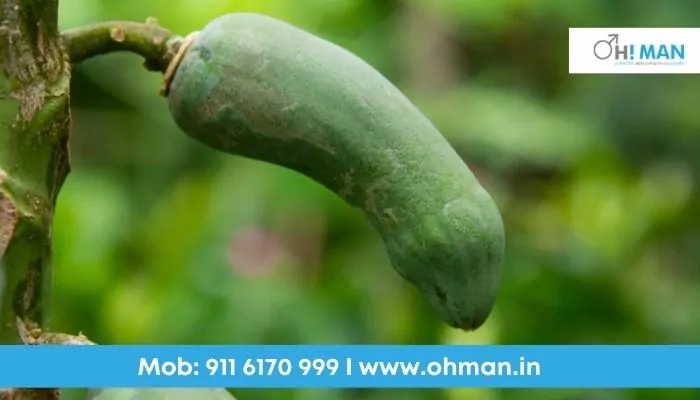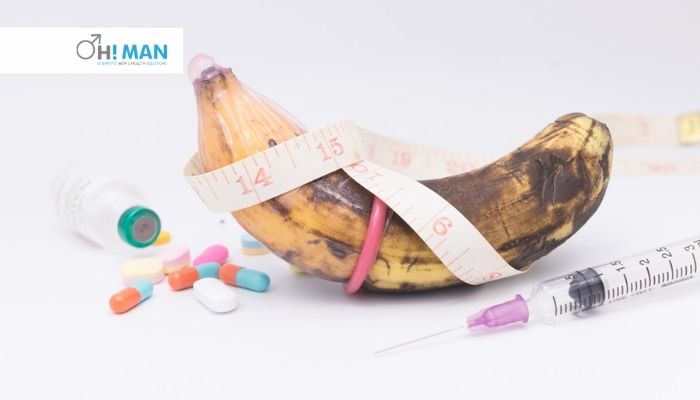What is Posthitis? Its Causes, Symptoms and Treatment?
What is Posthitis? Its Causes, Symptoms and Treatment?

What is Posthitis?
“Posthitis is an inflammation of the penis foreskin due to which the foreskin of the penis becomes painful & uncomfortable. The foreskin or prepuce is a thin skin layer covering over the penis head.”
- Causes of Posthitis
- Posthitis Symptoms
- When Should You See a Doctor?
- Diagnosis of Posthitis
- Treatment of Posthitis
- Antibiotic & Antifungal Treatment of Posthitis in adults
- Diabetes Control
- Some Similar Conditions
- Difference between Posthitis, Balanitis and Balanoposthitis
- Modern Laser treatment- Laser circumcision for posthitis
- Benefits of Laser Circumcision
- Adopt Better Hygiene to Prevent Posthitis
- Conclusion
- Frequently Asked Questions
Posthitis or other penile inflammation are usually caused by bacterial infection, poor hygiene, skin conditions, or unprotected sexual activities, which causes sexually transmitted diseases, and the Nature of these infections can be infectious and noninfectious. However, posthitis is not a sexually transmitted disease & most of the time it is not a serious condition It is wise to seek medical treatment to avoid future spread or complications in the penile foreskin.
Prepuce or foreskin is a layer of skin above the penis that covers the head of the penis. The foreskin does not retract in a newborn child and remains closed above the head. It starts retracting around the age of 2 to 6 years.
Circumcision is a surgical treatment that is often used on children due to some cultural bound. Circumcision is the best method to avoid future penile foreskin problems, and many parents choose to circumcise their children. According to the CDC, 58.3% is the circumcision rate of newborn children in America.
Although it’s common in children, adults might opt for this procedure. However, it takes longer for adults to circumcise than children. Additionally, there may also be psychological or physical complications. It may, however, reduce your risk for certain conditions like balanitis and paraphimosis.
Causes of Posthitis
Many things can contribute to posthitis causes. These could include:
- Bacterial – Posthitis can occur from a bacterial infection. Also, this may occur from fecal matter in some cases.
- Fungal: The area below the foreskin should be warm and moist. Posthitis is due to a fungal infection, candidiasis. Moreover, poor hygiene can lead to a fungal infection.
- Sexually transmitted infections (STI): Infections such as Gonorrhea can cause posthitis.
- Dermatological Information: Certain skin conditions, such as psoriasis and eczema, may lead to inflammation of the foreskin.
- Allergic reactions to hygiene products or latex condoms can cause foreskin swelling.
- Psoriasis or Dermatitis- Skin conditions such as dermatitis, psoriasis, and psoriasis are also significant posthitis in men causes. Further, these skin conditions can create allergic reactions in the genital region and produce inflammation of the prepuce.
- Diabetes mellitus- Men with uncontrolled diabetes are more likely to develop penile conditions such as posthitis. Higher sugar in the urine is the reason. Moreover, if the urine remains are left under the skin, they provide an ideal environment for microbes to colonize the harbor and can cause infections.
Posthitis Symptoms
Balanoposthitis can cause symptoms that extend beyond the penis. These symptoms may include:
- The foreskin is swelling
- Redness in the foreskin
- Itching
- smelly discharge
- Pain while urination and ejaculation
- tenderness
When Should You See a Doctor?
You should visit a doctor if you feel the following symptoms before & after the treatment :
- Symptoms are still appearing after 7 days of over-the-counter treatment
- Posthitis symptoms are worsening day by day
- Discharge or Bleeding from the infected area
- Regularly experiencing posthitis symptoms
If the condition remains persistent without a sign of healing, then the doctor may ask you to take other medicines or suggest a circumcision procedure.
Diagnosis of Posthitis
A physical exam is usually essential to diagnose posthitis. A doctor will be able to determine if the patient is suffering from posthitis, balanoposthitis, or any other form of penis inflammation.
A doctor might perform a swab test in some cases to find the source of inflammation. With the help of a long cotton swab, they will gently rub it on the skin.
If the doctor suspects that an STI causes posthitis, they will insert a swab in the penis opening. Some individuals may require a urine test.

Treatment of Posthitis
A person may visit a pharmacist if they believe they have posthitis. A pharmacist might be able to suggest an over-the-counter (OTC) treatment.
The underlying cause of posthitis will determine the treatment you receive. There are several options for treatment.
- Antibiotics – Antibiotics are vital for people who get an infection of posthitis due to bacteria; oral metronidazole is often prescribed for 7 days for treatment.
- Antifungal medication: Posthitis is a fungal infection that causes symptoms to worsen.
- Antihistamine – The person adopts antihistamines in case an allergic reaction causes posthitis.
- Steroid cream: A person with posthitis may need steroid cream due to a skin condition. These products can reduce inflammation and soothe the skin.
Antibiotic & Antifungal Treatment of Posthitis in adults
- Topical imidazole (ketoconazole, econazole)– This ointment is good for posthitis when the primary cause is a bacterial infection.
- Miconazole 2% – This is another often-used topical treatment for posthitis that successfully combats inflammation and relieves penile discomfort.
- Sulconazole 1% ointment – This ointment is most beneficial in mild instances of posthitis.
A person may also need to avoid possible irritants. They may also need to avoid having sexual intercourse, which could irritate the skin.
If the patient suffers from posthitis symptoms, it may be worth bathing their penis twice daily with a weak saline solution, providing some relief.
Diabetes Control
You need your doctor’s help to maintain your blood sugar level if your posthitis is caused by diabetes. According to NCBI balanoposthitis and Posthitis can be treated with diabetes management and good hygiene. You can stay active, eat healthy foods, and keep your diabetes under control.
Sometimes, the condition can recur even after trying the posthitis mentioned above treatments. However, if you have persistent or severe posthitis, surgery is the best option.
Many people fear Surgery. Further, it is easy to understand why people fear surgery, and we don’t want to have to suffer the pain and complications of traditional surgery.
Moreover, open circumcision can be a complex procedure that causes pain and discomfort for many weeks.
We will also tell you more about modern laser circumcision. So, laser treatment is painless, and let’s learn more.
Some Similar Conditions
Posthitis is not only a foreskin problem that affects your penile health. There are several infections that affect you. Let’s check them out-
Phimosis
Phimosis refers to a condition where a man cannot pull his foreskin onto the forehead of the penis. This condition is also known as ‘tight foreskin,’ and children’s foreskin begins to retract at two to six years.
So, the inability to move the penis freely while erection can cause pain/discomfort, retention of some urine, the appearance of smegma, and infection.
Paraphimosis
Paraphimosis, the opposite of phimosis, means that the foreskin cannot be pulled back onto a penis’ head. It will cause inflammation on the forehead of the penis and block blood flow to the glans. It is also a case of a medical emergency. When topical creams and ointments fail to work, circumcision is a permanent treatment for Paraphimosis and phimosis.
Balanitis
When the glands of the penis are swelling, Balanitis happens. The glans can swell, causing the foreskin not to stretch correctly, and this causes pain and reddening. Balanitis is most often caused by infection and can be treated with antibiotics.
Balanoposthitis
When both penis glands and the foreskin inflammation happen, it is called the case of Balanoposthitis. Balanoposthitis is a condition found in up to 6% of uncircumcised males.
Difference between Posthitis, Balanitis, and Balanoposthitis –
Balanitis is an infection of the penile glans, and posthitis is inflammation of the foreskin. However, balanoposthitis combines these conditions and specifically infects men with an uncircumcised penis. However, the difference between these infections is pretty much straightforward. Still, these terms are often interchangeably and inappropriately used in clinics and literature.
Modern Laser treatment- Laser circumcision for posthitis
The modern method of circumcision uses laser light to expel the penis’ inflamed prepuce. However, it will be a surprise to learn that laser circumcision does not involve stitches or wounds, and you need not worry about a long recovery time after laser circumcision.
Laser circumcision can be performed outpatient, so you don’t have to stay in the hospital for several days. Moreover, the patient can return home following the surgery without hospitalization.
Benefits of Laser Circumcision:
- The entire process will complete within 15 to 20 minutes.
- Laser circumcision is painless
- There is no bleeding involved.
- After the procedure, there is no chance of infection or hematoma.
- Laser circumcision causes minimal swelling and pain.
- Laser circumcision allows for quick recovery.
Adopt Better Hygiene to Prevent Posthitis
- You can keep your penis clean by washing them every day. So, this is a simple but essential hygiene tip that is often overlooked.
- Avoid harsh soaps or chemicals that could irritate the skin of your penis.
- Use a mild, unscented soap if necessary. Also, an emollient is helpful as it is readily available.
Conclusion
Posthitis (inflammation of the foreskin) is not a medical emergency unless it doesn’t resolve within a week. If you experience pain in sex, urination, or other symptoms, you should see a sexologist. Further, if you are experiencing any smelly sensations, such as a yellowish-white substance under your foreskin or swelling, it is time to consult a reputable sexologist.
Further, you can try to wash your penis frequently and see if it improves. If not, then you should consult the doctor soon.
At Ohman, our experienced specialists can offer the proper medical treatment for any medical conditions relating to men’s sexual health. The specialists have years of experience. So, you can book an online consultation at our official website and have a detailed conversation with our specialists.
Frequently Asked Questions
1. Is balanitis and Posthitis the same?
No, both are different. Balanitis is the specific term for infection of the penis glans. Posthitis is an inflammatory condition affecting only the prepuce. In clinical practice, these phrases are frequently used interchangeably and incorrectly.
2. What antibiotics treat Posthitis?
Mild cases treatment is possible with topical metronidazole. But severe cases of Posthitis will require oral antibiotics treatment. Your doctor may recommend oral metronidazole for a week.
3. How long does it take for Posthitis to go away?
Generally, posthitis is not a severe medical emergency; it can resolve within a week on its own. However, if it does not go away on its own, medical treatment is required to resolve it. Initial therapy can fix it in three to five days. However, if left untreated, it might grow more uncomfortable or result in other health concerns. Further, you must undergo the proper treatment for your condition.
4. How do you prevent Posthitis?
Hygiene, particularly frequent washing and cleaning of your genitals, is typically regarded adequate to avoid infection and irritation.
5. Is Vaseline good for Posthitis?
Using a neutral ointment (e.g. basic Vaseline) to the glans and foreskin on a regular basis may assist in establishing a protective layer.
6. What cream is best for balanitis?
he most frequent therapy for yeast-caused balanitis is topical canesten 1% cream (clotrimazole, Lotrimin); the recommended duration of treatment is around 2 weeks to 1 month. Additionally, lotrisone (a mixture of betamethasone and clotrimazole) is also advisable.
7. Can I have Sex and do Masturbation If I have Posthitis?
Posthitis is not a sexually transmitted infection. A person suffering from posthitis can still engage in sexual intercourse and masturbation. However, inflammation in your penis during posthitis may cause irritation and discomfort during Sex and masturbation. So avoiding masturbation and sexual intercourse can help you heal faster from it. If you still decide to have sexual intercourse during posthitis, it is best to get advice from your doctor and be open with your partner about your situation. In addition, try to maintain hygiene during intercourse, clean and apply medication right after intercourse.
8. Can a circumcised penis get infected with posthitis?
Circumcision is a method to remove the male penile foreskin from the body, many cultures perform this as a ritual, and sometimes it is committed to cure diseases or stop infections. However, a Circumcised penis has a lower risk of infection than an uncircumcised penis. Still, infections like balanitis can affect the circumcised penis because it affects the penis glans and skin. However, posthitis is an isolated inflammation of the prepuce, and a circumcised penis cannot get infected from posthitis. According to the International Journal of Preventive Medicine, it is false to think that posthitis and balanoposthitis are rare in circumcised men. However, many neglected children in their diapers still develop infections due to a lack of hygiene and previously untreated infections.



